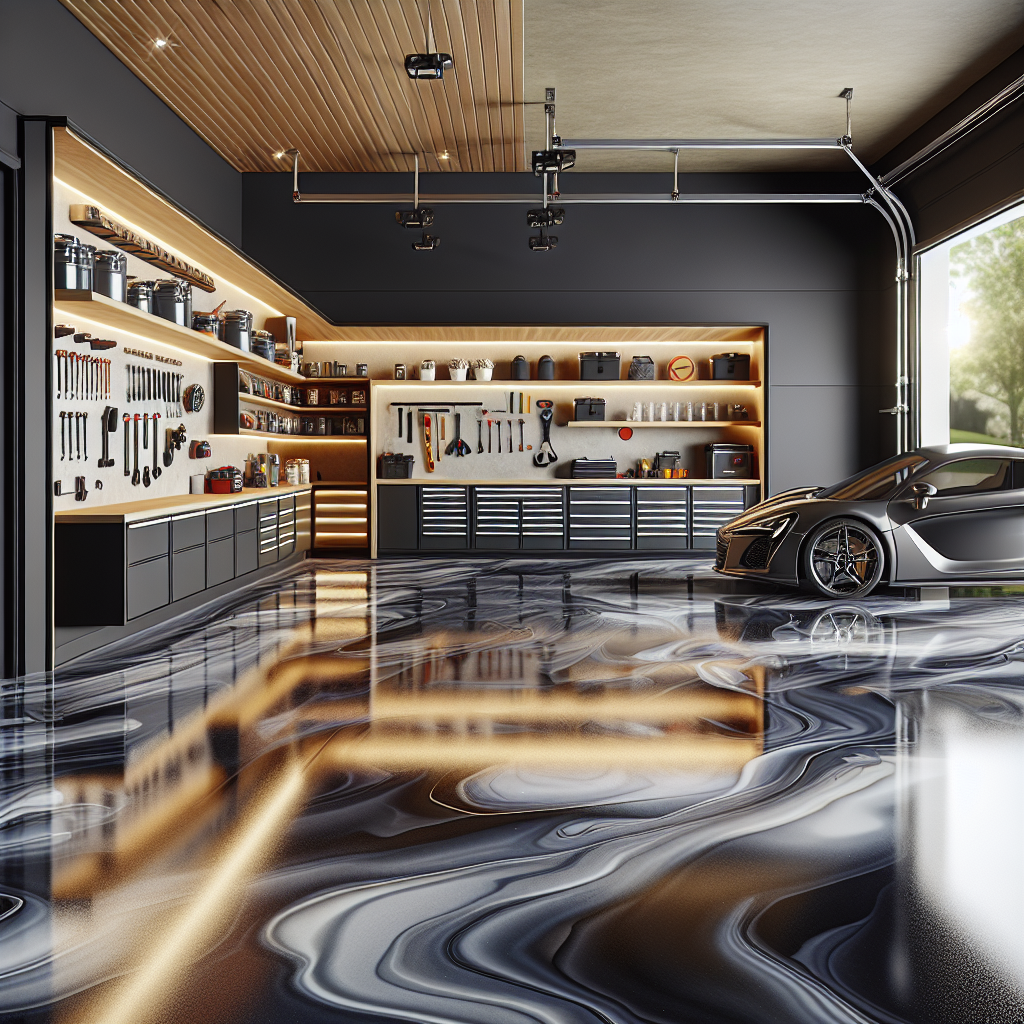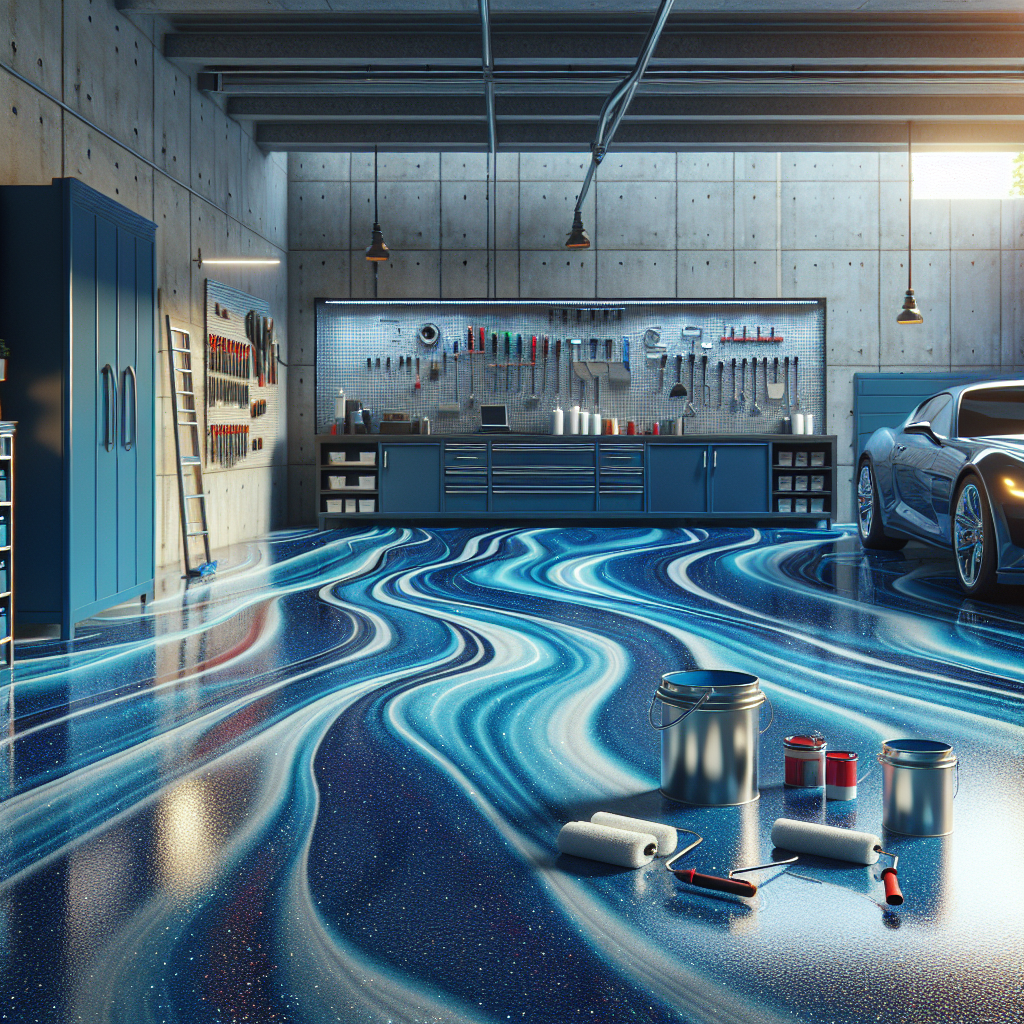When considering the best epoxy for a garage floor, it’s essential to understand what epoxy coatings are and how they can elevate the functionality and aesthetics of your garage. Epoxy is a durable resin that, when mixed with a hardener, forms a tough, resilient surface that can withstand heavy traffic, chemicals, and abrasions.
One of the primary advantages of using epoxy coatings is their superior adhesion to concrete surfaces, which helps prevent peeling and chipping over time. They come in a variety of formulations, including:
- Solid Epoxy: Known for its high durability and gloss finish, solid epoxy is great for high-traffic areas.
- Water-Based Epoxy: This option is easier to apply and clean, making it ideal for DIY enthusiasts.
- Solvent-Based Epoxy: Offers a high-gloss finish and excellent durability but requires proper ventilation during application.
Additionally, epoxy coatings can be customized with colors, patterns, and even anti-slip additives, enhancing both safety and appearance. The installation process typically involves surface preparation, mixing the epoxy, and applying it in layers, which leads to a long-lasting finish.
For those looking to transform their garage space, understanding these nuances will help in selecting the right product. Call Us Today for a Free Quote on your epoxy floor installation project and discover how you can achieve the best results for your garage floor!
Benefits of Using Epoxy for Garage Flooring

Choosing epoxy for your garage flooring comes with a myriad of advantages that contribute to both functionality and aesthetics. Here are some key benefits:
- Durability: Epoxy coatings are incredibly tough and can endure heavy foot traffic, vehicle weight, and various impacts without showing signs of wear.
- Resistance to Chemicals: Garage floors are often exposed to oils, gasoline, and other chemicals. Epoxy provides a protective barrier that resists staining and damage from these substances.
- Easy Maintenance: Cleaning epoxy floors is a breeze. A simple sweep and occasional mopping with mild detergent will keep your floor looking pristine.
- Enhanced Safety: Epoxy flooring can be customized with anti-slip additives, reducing the risk of slips and falls, which is particularly important in a garage environment where spills can occur.
- Improved Aesthetics: Available in various colors and finishes, epoxy can transform a dull concrete floor into a vibrant and attractive space, enhancing the overall look of your garage.
- Cost-Effective: While the initial investment may seem significant, the long-term benefits and durability of epoxy flooring make it a cost-effective option over time.
By incorporating epoxy into your garage flooring solution, you not only protect your investment but also create a space that is functional, safe, and visually appealing.
Choosing the Best Epoxy for Your Garage

Selecting the best epoxy for a garage floor requires careful consideration of various factors to ensure that you achieve the optimal results for your unique space. Here are some essential aspects to keep in mind:
- Type of Epoxy: There are several types of epoxy systems available, including 100% solid epoxy, water-based epoxy, and solvent-based epoxy. Each type has its own benefits, with 100% solid epoxy being the most durable and long-lasting option.
- Thickness: The thickness of the epoxy layer can significantly impact its durability and performance. A thicker application generally provides better protection against damage and wear.
- Color and Finish: Consider the aesthetic appeal by choosing a color and finish that complements your garage design. Options range from glossy to matte finishes, and you can even add decorative chips for a unique look.
- Application Method: Some epoxy products are easier to apply than others. If you’re planning a DIY project, look for user-friendly options that come with clear application instructions.
- Drying and Curing Time: Be aware of the drying and curing times for the epoxy you select. Some products may require longer periods before they can withstand foot and vehicle traffic.
- Warranty: Verify if the epoxy comes with a warranty. A solid warranty often indicates the manufacturer’s confidence in their product’s durability and performance.
By taking these factors into account, you can confidently choose the best epoxy for your garage, ensuring it meets your needs for durability, aesthetics, and ease of maintenance.
Step-by-Step Epoxy Floor Installation Guide

Installing an epoxy floor in your garage can be a rewarding project that enhances both the functionality and appearance of the space. Follow this step-by-step epoxy floor installation guide to ensure a successful application:
- Prepare the Surface: Begin by cleaning the garage floor thoroughly. Remove any dirt, oil, or grease stains using a degreaser. For optimal adhesion, consider using a concrete grinder to smooth out the surface and create a profile that allows the epoxy to bond effectively.
- Repair Cracks: Inspect the floor for any cracks or holes, and repair them using a concrete patching compound. Allow the repairs to cure completely before proceeding.
- Choose Your Epoxy: Select the appropriate epoxy based on your earlier considerations, such as thickness and type. Ensure you have all necessary tools at hand, including rollers, brushes, and a mixing bucket.
- Mix the Epoxy: Follow the manufacturer’s instructions for mixing the epoxy components. Proper mixing is crucial for achieving the right consistency and performance.
- Apply the Primer: If your epoxy product requires a primer, apply it uniformly across the surface using a roller. This step helps enhance adhesion and ensures even application.
- Apply the Epoxy: Once the primer is dry, begin applying the epoxy. Work in sections, using a roller for larger areas and a brush for edges and corners. Be sure to maintain a wet edge to avoid lap marks.
- Add Decorative Chips (Optional): If desired, sprinkle decorative chips onto the wet epoxy to create a textured finish. This step adds visual interest and can help hide imperfections.
- Allow to Cure: Follow the manufacturer’s guidelines for curing time. Keep the area well-ventilated and avoid foot or vehicle traffic until the epoxy is fully cured.
- Apply a Topcoat (Optional): For added protection, you may choose to apply a topcoat, especially in high-traffic areas. This step can enhance the durability and longevity of your epoxy floor.
By adhering to these steps, you can ensure a professional-looking epoxy floor that will serve you well for years to come.
Maintenance Tips for Epoxy Garage Floors
To keep your epoxy garage floor looking pristine and functioning effectively, proper maintenance is essential. Here are some maintenance tips for epoxy garage floors that will help prolong their lifespan:
- Regular Cleaning: Sweep or vacuum the floor regularly to remove dust, dirt, and debris. For deeper cleaning, use a mild detergent mixed with warm water and a mop. Avoid using harsh chemicals that can damage the epoxy finish.
- Immediate Spill Cleanup: Promptly clean spills, especially oil or chemical stains, to prevent them from penetrating the surface. Use absorbent materials like rags or kitty litter to soak up spills before cleaning with a suitable cleaner.
- Avoid Heavy Objects: While epoxy floors are durable, avoid dragging heavy items across the surface. This can scratch or chip the epoxy. Use furniture pads or sliders when moving heavy equipment or tools.
- Control Moisture: High humidity can affect the integrity of the epoxy. If your garage has high moisture levels, consider using a dehumidifier to maintain optimal conditions.
- Periodic Inspections: Regularly inspect the floor for any signs of wear or damage. Address minor issues promptly to prevent them from escalating into more significant problems.
- Reapply Coating as Necessary: Depending on the level of traffic and wear, you may need to reapply a topcoat or sealant every few years to maintain the floor’s appearance and protection.
- Use Appropriate Mats: If you frequently work in the garage, consider using mats in areas of high use. This will help protect the epoxy surface from wear and tear caused by repetitive actions.
By following these maintenance tips, you can ensure that your epoxy garage floor remains visually appealing and functional for years to come.
Common Mistakes to Avoid When Applying Epoxy

Applying epoxy flooring can transform your garage, but it’s crucial to avoid common pitfalls that can compromise the quality of the installation. Here are some common mistakes to avoid when applying epoxy:
- Skipping Surface Preparation: One of the most critical steps is properly preparing the surface. Failing to clean, grind, or etch the concrete can lead to poor adhesion and premature peeling of the epoxy.
- Ignoring Temperature and Humidity: Epoxy application requires specific temperature and humidity conditions. Applying epoxy in cold or humid environments can negatively affect curing times and overall performance. Always check the manufacturer’s guidelines.
- Using Incompatible Products: Ensure that the epoxy resin and hardener you choose are compatible. Mixing products from different manufacturers can result in unexpected chemical reactions and poor finishes.
- Rushing the Process: Take your time with each step of the application process. Rushing through the mixing, pouring, or curing phases can lead to mistakes that affect the floor’s durability and appearance.
- Neglecting Safety Precautions: Always wear appropriate safety gear, including gloves, goggles, and masks. Epoxy fumes can be harmful, and proper ventilation is essential during the application process.
- Overlooking the Importance of a Primer: Applying a primer coat before the epoxy can significantly enhance adhesion and durability. Skipping this can lead to issues down the line.
Being aware of these common mistakes can help ensure a successful epoxy floor application. If you need assistance with your epoxy floor installation, call us today for a free quote and let our experts guide you through the process!


